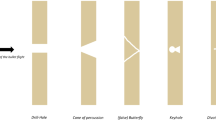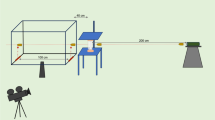Abstract
Methodologies that improve estimation of caliber from cranial bone defects are necessary to meet the ever increasing admissibility standards. The relationship between caliber, wound diameter, and bone mineral density (BMD) was examined. The formation of the permanent cavity is influenced by bullet yaw, velocity, distance, and tissue properties. The hypothesis was that including BMD, wound diameter could be explained by differences in caliber. The sample consists of 68 autopsy sections and 101 specimens from Phelps (1898). A subsample of 18 was scanned using dual energy x-ray absorptiometry (DEXA) for BMD measurement to test whether an increase in BMD affects wound diameter. Pearson product-moment correlations of the subsample indicate the strongest correlation is between BMD and minimum diameter (r = 0.7101), followed by a correlation between minimum diameter and caliber (r = 0.6854). Despite the previous use of thickness as a proxy for BMD, no correlation was found between BMD and thickness (r = 0.0143). A multivariate analysis of variance (MANOVA) detected a significant influence of BMD and minimum diameter on caliber size (Prob > F = 0.0003). The logistic regression shows that caliber can be estimated from minimum diameter. Using the subsample, the results show that the inclusion of BMD strengthens the model for estimating caliber from entrance gunshot defects.
Similar content being viewed by others
References
Berryman H, Lanfear AK, Shirley N (2012) The biomechanics of gunshot trauma to bone: research considerations within the present judicial climate. In Dirkmaat D (ed) A companion to forensic anthropology. John Wiley & Sons, Ltd, Chichester doi: 10.1002/9781118255377.ch18
Berryman H, Smith O, Symes S (1995) Diameter of cranial gunshot wounds as a function of bullet caliber. J Forensic Sci 40(5):751
Ross A (1996) Caliber estimation from cranial entrance defect measurements. J Forensic Sci 41(4):629
Huelke D, Buege L, Harger J (1967) Bone fractures produced by high velocity impacts. Am J Anat 120(1):123–131
Barach E, Tomlanovich M, Nowak R (1986) Ballistics: a pathophysiologic examination of the wounding mechanisms of firearms: part I. J Trauma 26(3):225
Coupland R, Kneubuehl B, Rothschild M, Thali M (2011) Wound ballistics: basics and applications. Springer, Berlin
DiMaio V (1999) Gunshot wounds: practical aspects of firearms, ballistics, and forensic techniques. CRC Press, Boca Raton
Farjo L, Miclau T (1997) Ballistics and mechanisms of tissue wounding. Injury 28:C12–C17
Heard B (2008) Handbook of firearms and ballistics: examining and interpreting forensic evidence. John Wiley And Sons, New Jersey
Bartlett C (2003) Clinical update: gunshot wound ballistics. Clin Orthop Relat Res 408:28–57
Kieser J, Taylor M, Carr D (2012) Biomechanics of bone and bony trauma. In: Forensic biomechanics. John Wiley& Sons, Ltd., Chichester, pp. 35–69
Quatrehomme G, Işcan M (1999) Characteristics of gunshot wounds in the skull. J Forensic Sci 44(3):568
Evan M, Sanow E (1992) Handgun stopping power: the definitive study. Paladin Press, Boulder
Mota A, Klub W, Pandolfi A (2003) Finite-element simulation of firearm injury to the human cranium. Comput Mech 31(1–2):115–121
Quatrehomme G, I̊şcan M (1998) Gunshot wounds to the skull: comparison of entries and exits. Forensic Sci Int 94(1):141–146
Russell M, Noguchi T (1999) Gunshot wounds and ballistics: forensic concerns. Top Emerg Med 21(3):1–10
Tamaska L (1964) Critical observations on the question of determination of caliber of a projectile from its entrance hole in bone. Zacchia 27:158–170
Phelps C (1898) Traumatic injuries of the brain and its membranes: with a special study of pistol-shot wounds of the head in their medicolegal and surgical relations. Henry Kimpton, London, pp. 298–333
Moore M, Schaefer E (2011) A comprehensive regression tree to estimate body weight from the skeleton. J Forensic Sci 56(5):1115
Mertler C, Vannatta R (2005) Advanced and multivariate statistical methods practical application and interpretation, 3 ed) edn. Pyrczak Publishing, Glendale
SAS Institute Inc. (2015) JMP 12 basic analysis. SAS Institute Inc., Cary
Peterson B (1991) External beveling of cranial gunshot entrance wounds. J Forensic Sci 36(5):1592
DiMaio V (2015) Gunshot wounds: practical aspects of firearms, ballistics, and forensic techniques. CRC Press, Boca Raton, p. 259
Currey J (2002) Bones: structure and mechanics. Princeton University Press, Princeton
Maynard L, Guo S, Chumlea W, Roche A, Wisemandle W, Zeller C, Siervogel R (1998) Total-body and regional bone mineral content and areal bone mineral density in children aged 8-18 y: the Fels longitudinal study. Am J Clin Nutr 68(5):1111
Garg M, Kharb S (2013) Dual energy x-ray absorptiometry: pitfalls in measurement and interpretation of bone mineral density. India J Endocrinol Metab 17(2):203–210. doi:10.4103/2230-8210.109659
Author information
Authors and Affiliations
Corresponding author
Ethics declarations
Conflict of interest
The authors declare that they have no conflict of interest.
Rights and permissions
About this article
Cite this article
Paschall, A., Ross, A.H. Bone mineral density and wounding capacity of handguns: implications for estimation of caliber. Int J Legal Med 131, 161–166 (2017). https://doi.org/10.1007/s00414-016-1420-6
Received:
Accepted:
Published:
Issue Date:
DOI: https://doi.org/10.1007/s00414-016-1420-6




